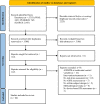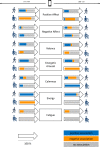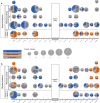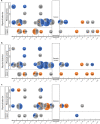The Within-Subject Association of Physical Behavior and Affective Well-Being in Everyday Life: A Systematic Literature Review
- PMID: 38705972
- PMCID: PMC11239742
- DOI: 10.1007/s40279-024-02016-1
The Within-Subject Association of Physical Behavior and Affective Well-Being in Everyday Life: A Systematic Literature Review
Abstract
Background: The interplay of physical activity (PA) with affective well-being (AWB) is highly critical to both health behaviors and health outcomes. Current prominent theories presume AWB to be crucial for PA maintenance, and PA is evidenced to foster mental health. However, thus far, PA-AWB associations have mainly been researched in laboratory settings and with interventional designs, but the everyday life perspective had not been focused on, mostly due to technological limitations. In the course of digitization, the number of studies using device-based methods to research the within-subject association of physical activity and affective well-being (PA-AWB) under ecological valid conditions increased rapidly, but a recent comprehensive systematic review of evidence across populations, age groups, and distinct AWB components remained inconclusive.
Objectives: Therefore, we aimed to firstly review daily-life studies that assessed intensive longitudinal device-based (e.g., electronic smartphone diaries and accelerometry) and real-time PA-AWB data, secondly to develop and apply a quality assessment tool applicable to those studies, and thirdly to discuss findings and draw implications for research and practice.
Methods: To this end, the literature was searched in three databases (Web of Science, PubMed, Scopus) up to November 2022. The systematic review followed the PRISMA guidelines and had been pre-registered (PROSPERO id: CRD42021277327). A modified quality assessment tool was developed to illustrate the risk of bias of included studies.
Results: The review of findings showed that, in general, already short PA bouts in everyday life, which clearly differ from structured exercise sessions, are positively associated with AWB. In particular, feelings of energy relate to incidental (non-exercise and unstructured) activity, and PA-AWB associations depend on population characteristics. The quality assessment revealed overall moderate study quality; however, the methods applied were largely heterogeneous between investigations. Overall, the reviewed evidence on PA-AWB associations in everyday life is ambiguous; for example, no clear patterns of directions and strengths of PA-AWB relationships depending on PA and AWB components (such as intensity, emotions, affect, mood) emerged.
Conclusions: The reviewed evidence can fuel discussions on whether the World Health Organization's notion "every move counts" may be extended to everyday life AWB. Concurrently, the PA-AWB relationship findings endorse prominent theories highlighting the critical role of AWB in everyday PA engagement and maintenance. However, the review also clearly highlights the need to advance and harmonize methodological approaches for more fine-grained investigations on which specific PA/AWB characteristics, contextual factors, and biological determinants underly PA-AWB associations in everyday life. This will enable the field to tackle pressing challenges such as the issue of causality of PA-AWB associations, which will help to shape and refine existing theories to ultimately predict and improve health behavior, thereby feeding into precision medicine approaches.
© 2024. The Author(s).
Conflict of interest statement
UWE-P reports consultancy for Boehringer-Ingelheim and speaker honorarium from Angelini Pharma. The authors declare that they have no competing interests.
Figures






Similar articles
-
Home treatment for mental health problems: a systematic review.Health Technol Assess. 2001;5(15):1-139. doi: 10.3310/hta5150. Health Technol Assess. 2001. PMID: 11532236
-
Education support services for improving school engagement and academic performance of children and adolescents with a chronic health condition.Cochrane Database Syst Rev. 2023 Feb 8;2(2):CD011538. doi: 10.1002/14651858.CD011538.pub2. Cochrane Database Syst Rev. 2023. PMID: 36752365 Free PMC article.
-
Physical activity and exercise for chronic pain in adults: an overview of Cochrane Reviews.Cochrane Database Syst Rev. 2017 Apr 24;4(4):CD011279. doi: 10.1002/14651858.CD011279.pub3. Cochrane Database Syst Rev. 2017. PMID: 28436583 Free PMC article.
-
Physical activity and exercise for chronic pain in adults: an overview of Cochrane Reviews.Cochrane Database Syst Rev. 2017 Jan 14;1(1):CD011279. doi: 10.1002/14651858.CD011279.pub2. Cochrane Database Syst Rev. 2017. Update in: Cochrane Database Syst Rev. 2017 Apr 24;4:CD011279. doi: 10.1002/14651858.CD011279.pub3. PMID: 28087891 Free PMC article. Updated.
-
Systemic pharmacological treatments for chronic plaque psoriasis: a network meta-analysis.Cochrane Database Syst Rev. 2021 Apr 19;4(4):CD011535. doi: 10.1002/14651858.CD011535.pub4. Cochrane Database Syst Rev. 2021. Update in: Cochrane Database Syst Rev. 2022 May 23;5:CD011535. doi: 10.1002/14651858.CD011535.pub5. PMID: 33871055 Free PMC article. Updated.
Cited by
-
Relationship between nonexercise activity and mood in patients with eating disorders.Acta Psychiatr Scand. 2025 Mar;151(3):448-462. doi: 10.1111/acps.13757. Epub 2024 Sep 7. Acta Psychiatr Scand. 2025. PMID: 39244381 Free PMC article.
-
Causal effects of sedentary breaks on affective and cognitive parameters in daily life: a within-person encouragement design.Npj Ment Health Res. 2024 Dec 21;3(1):64. doi: 10.1038/s44184-024-00113-7. Npj Ment Health Res. 2024. PMID: 39706901 Free PMC article.
-
Physical activity, health, and life satisfaction: Four panel studies demonstrate reciprocal effects.Appl Psychol Health Well Being. 2025 May;17(2):e70027. doi: 10.1111/aphw.70027. Appl Psychol Health Well Being. 2025. PMID: 40223684 Free PMC article.
-
Contexts, affective and physical states and their variations during physical activity in older adults: an intensive longitudinal study with sensor-triggered event-based ecological momentary assessments.Int J Behav Nutr Phys Act. 2025 Mar 7;22(1):30. doi: 10.1186/s12966-025-01724-9. Int J Behav Nutr Phys Act. 2025. PMID: 40055798 Free PMC article.
-
Associations between daily composition of 24 h physical behavior with affective states and working memory.Sci Rep. 2025 Apr 25;15(1):14455. doi: 10.1038/s41598-025-99266-4. Sci Rep. 2025. PMID: 40281136 Free PMC article.
References
-
- World Health Organization. Global status report on physical activity 2022. World Health Organization. 2022. https://iris.who.int/bitstream/handle/10665/363607/9789240059153-eng.pdf.... Accessed 15 Apr 2023.

